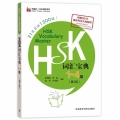- 出版社: 北京语言大学出版社; 第1版 (2014年12月1日)
- 平装: 185页
- 语种: 简体中文, 英语
- 开本: 16
- ISBN: 9787561939949
- 条形码: 9787561939949
- 商品尺寸: 25.8 x 18.2 x 1.2 cm
- 商品重量: 240 g
商品描述
编辑推荐
《新HSK应试全解析:3级》特色:题型说明、答题技巧;重要考点、真题例释;应试要点、练习解答;专项讲练、模拟试卷。
目录
HSK(三级)考试介绍
第一单元听力
第一部分
题型特点
真题分析
专项练习(一)
听力文本和答案
第二部分
题型特点
真题分析
考点预测及答题技巧
专项练习(二)
听力文本和答案
第三部分
题型特点
真题分析
考点预测及答题技巧
专项练习(三)
听力文本和答案
第四部分
题型特点
真题分析
考点预测及答题技巧
专项练习(四)
听力文本和答案
第二单元阅读
第一部分
题型特点
考点分析及答题技巧
专项练习(五)
答案
第二部分
题型特点
考点分析及答题技巧
专项练习(六)
答案
第三部分
题型特点
真题分析
考点预测及答题技巧
专项练习(七)
答案
第三单元书写
第一部分
题型特点
真题分析及答题技巧
考点预测
专项练习(八)
答案
第二部分
题型特点
真题分析及答题技巧
专项练习(九)
答案
第四单元模拟试卷
模拟试卷一
模拟试卷二
模拟试卷三
模拟试卷四
模拟试卷五
模拟试卷听力文本和答案
答题卡
第一单元听力
第一部分
题型特点
真题分析
专项练习(一)
听力文本和答案
第二部分
题型特点
真题分析
考点预测及答题技巧
专项练习(二)
听力文本和答案
第三部分
题型特点
真题分析
考点预测及答题技巧
专项练习(三)
听力文本和答案
第四部分
题型特点
真题分析
考点预测及答题技巧
专项练习(四)
听力文本和答案
第二单元阅读
第一部分
题型特点
考点分析及答题技巧
专项练习(五)
答案
第二部分
题型特点
考点分析及答题技巧
专项练习(六)
答案
第三部分
题型特点
真题分析
考点预测及答题技巧
专项练习(七)
答案
第三单元书写
第一部分
题型特点
真题分析及答题技巧
考点预测
专项练习(八)
答案
第二部分
题型特点
真题分析及答题技巧
专项练习(九)
答案
第四单元模拟试卷
模拟试卷一
模拟试卷二
模拟试卷三
模拟试卷四
模拟试卷五
模拟试卷听力文本和答案
答题卡
文摘
版权页:
There are 10 questions in total from 41 to 50.There are two groups of sentences.eachof which includes 5 sentences,and the examinees are requested to find the correspondingrelationship between the sentences.The questions of this part are aimed to examine theexaminees'ability in connection.
如“你知道怎么去哪儿吗?”这是上句。在选项中,“E当然。我们先坐公共汽车,然后换地铁。”是合适搭配的下句,因此E是正确答案。
For example,“你知道怎么去那儿吗?”(Do you know how to get there?1 is thepreceding sentence.Among the choices,Choice E,“当然。我们先坐公共汽车,然后换地铁。”(Of course.We may take bus at first,then change the SUbway)is the foilowingsentence corresponding to the preceding sentence.So E is the correct answer.
这部分题的上下文搭配关系主要有几种类型:话题衔接式、提问回答式、提醒告诫式、困难帮助式、原因结果式、对比式。
The contextual relationships in the questions of this part mainly include:topicconnection pattern,question—answer pattern,reminding and warning pattern,difficulty andhelp pattern,cause—effect pattern,and comparison pattern.
1.话题衔接式Topic Connection Pattern
话题衔接式搭配关系的特点是:上文和下文谈及相同的话题,体现在用词上,有体现同一话题的相关词语,如:
The characteristics of the topic connection pattem are:the same topic is mentioned inthe context;and related words or phrases indicating the same topic occur in the context,e.g.:
2.提问回答式Question.Answer Pattern
提问回答式搭配关系的特点是:上文提问,选择合适的下文回答。如:
The characteristics of the question—answer pattern are:a question is asked in thepreceding paragraph and the examinees are requested to choose the correct followingparagraph,e.g.:
下文的回答有些是比较直接的回答,有些是比较间接、隐晦的回答,这要求考生仔细辨识。
如“你知道怎么去哪儿吗?”这是上句。在选项中,“E当然。我们先坐公共汽车,然后换地铁。”是合适搭配的下句,因此E是正确答案。
For example,“你知道怎么去那儿吗?”(Do you know how to get there?1 is thepreceding sentence.Among the choices,Choice E,“当然。我们先坐公共汽车,然后换地铁。”(Of course.We may take bus at first,then change the SUbway)is the foilowingsentence corresponding to the preceding sentence.So E is the correct answer.
这部分题的上下文搭配关系主要有几种类型:话题衔接式、提问回答式、提醒告诫式、困难帮助式、原因结果式、对比式。
The contextual relationships in the questions of this part mainly include:topicconnection pattern,question—answer pattern,reminding and warning pattern,difficulty andhelp pattern,cause—effect pattern,and comparison pattern.
1.话题衔接式Topic Connection Pattern
话题衔接式搭配关系的特点是:上文和下文谈及相同的话题,体现在用词上,有体现同一话题的相关词语,如:
The characteristics of the topic connection pattem are:the same topic is mentioned inthe context;and related words or phrases indicating the same topic occur in the context,e.g.:
2.提问回答式Question.Answer Pattern
提问回答式搭配关系的特点是:上文提问,选择合适的下文回答。如:
The characteristics of the question—answer pattern are:a question is asked in thepreceding paragraph and the examinees are requested to choose the correct followingparagraph,e.g.:
下文的回答有些是比较直接的回答,有些是比较间接、隐晦的回答,这要求考生仔细辨识。


















































